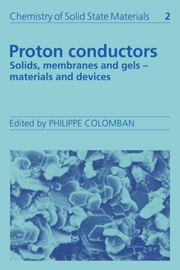Book contents
- Frontmatter
- Contents
- List of contributors
- Preface
- Symbols
- I HYDROGEN BOND AND PROTONIC SPECIES
- II MATERIALS: PREPARATION, STRUCTURES AND PROPERTIES
- 7 Structure and characterization of hydrogen insertion compounds of metal oxides
- 8 High temperature proton conductors based on perovskite-type oxides
- 9 Highly ionic hydroxides: unexpected proton conductivity in Mg(OH)2 and homologues
- 10 Ice
- 11 Anhydrous materials: oxonium perchlorate, acid phosphates, arsenates, sulphates and selenates
- 12 Hydrogen behaviour in graphite–nitric acid intercalation compounds
- 13 Proton-containing β- and β″-alumina structure type compounds
- 14 Proton conduction in zeolites
- 15 Proton containing NASICON phases
- 16 Phosphates and phosphonates of tetravalent metals as protonic conductors
- 17 Hydrogen uranyl phosphate, H3OUO4PO4. 3H2O (HUP), and related materials
- 18 From crystalline to amorphous (particle) hydrates: inorganic polymers, glasses, clays, gels and porous media
- 19 Perfluorinated membranes
- 20 Mixed inorganic-organic systems: the acid/polymer blends
- III PROTON DYNAMICS AND CHARGE TRANSPORT
- IV PROTON DIFFUSION MECHANISMS
- V DEVICES
- Index
11 - Anhydrous materials: oxonium perchlorate, acid phosphates, arsenates, sulphates and selenates
Published online by Cambridge University Press: 04 May 2010
- Frontmatter
- Contents
- List of contributors
- Preface
- Symbols
- I HYDROGEN BOND AND PROTONIC SPECIES
- II MATERIALS: PREPARATION, STRUCTURES AND PROPERTIES
- 7 Structure and characterization of hydrogen insertion compounds of metal oxides
- 8 High temperature proton conductors based on perovskite-type oxides
- 9 Highly ionic hydroxides: unexpected proton conductivity in Mg(OH)2 and homologues
- 10 Ice
- 11 Anhydrous materials: oxonium perchlorate, acid phosphates, arsenates, sulphates and selenates
- 12 Hydrogen behaviour in graphite–nitric acid intercalation compounds
- 13 Proton-containing β- and β″-alumina structure type compounds
- 14 Proton conduction in zeolites
- 15 Proton containing NASICON phases
- 16 Phosphates and phosphonates of tetravalent metals as protonic conductors
- 17 Hydrogen uranyl phosphate, H3OUO4PO4. 3H2O (HUP), and related materials
- 18 From crystalline to amorphous (particle) hydrates: inorganic polymers, glasses, clays, gels and porous media
- 19 Perfluorinated membranes
- 20 Mixed inorganic-organic systems: the acid/polymer blends
- III PROTON DYNAMICS AND CHARGE TRANSPORT
- IV PROTON DIFFUSION MECHANISMS
- V DEVICES
- Index
Summary
Proton-containing anhydrous materials are interesting proton conductors as they are stable to relatively high temperatures and contain fewer protons that do hydrates. Their conduction mechanism is thus expected to be easier to understand, and the proton diffusion may be investigated over a rather wide temperature range. However, the conduction mechanism can become complicated when the ‘melting’ temperatures of the protonic species and the non-protonic sublattice are close.
Oxonium perchlorate
Oxonium perchlorate H3OClO4 is the first solid proton conductor whose conductivity, σ300K = 3.4 × 10–4 Ω–1 cm–1, has been found to be comparable to that of a liquid electrolyte. It is also one of the first materials in which the oxonium ion has been identified. The compound is very hygroscopic and photosensitive. A glassy state can be obtained by quenching the molten salt (Tm = 55 °C)3. The crystalline phase undergoes a first order transition on cooling, at 249 K, with a slight volume increase. The low temperature phase is monoclinic with P21/n space group and four formula units in the unit cell. The structure consists of layers of oxonium and perchlorate ions hydrogen bonded by two short (O … O = 0.263 and 0.261 nm) and one long (O … O = 0.271 nm) hydrogen bond (Fig. 11.1).
- Type
- Chapter
- Information
- Proton ConductorsSolids, Membranes and Gels - Materials and Devices, pp. 165 - 182Publisher: Cambridge University PressPrint publication year: 1992
- 4
- Cited by



